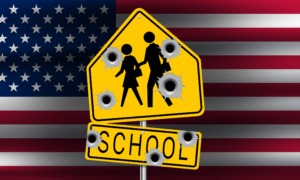
HelloRF Zcool/Shutterstock
.
Gun violence touches every community, but those most affected are also disproportionately exposed to poverty, poor education standards and fewer job opportunities. Firearm violence is also defined by startling racial and ethnic disparities. It is no wonder that the national sentiment has become one of frustration, a growing conviction that enough is enough.
The United States continues to significantly outpace peer nations in the volume of firearm injuries to which citizens are exposed. Almost 40,000 people were killed by guns in 2017, according to the Centers for Disease Control and Prevention.

Ruth Abaya
Exposure to violence can take many forms. Too many are direct victims, injured when altercations get out of hand, victimized by an intimate partner, brought to the point of desperation when grappling with crippling anxiety or depression, or bystanders in neighborhoods that are unsafe. Even more victims are loved ones, struggling against a culture of violence that tragically disrupts the lives and well-being of their families and communities.
And then there is greater society. Even for those who are fortunate enough to avoid being directly affected, through the news and social media the world grows smaller and the stories that may occur across the country fixate us at our kitchen tables miles away. Exposure to the steady trickle of stories of violence and inexplicable mass shootings make us feel that nowhere is safe.
It is worth underscoring, however, that mass shootings, which dominate the news cycle when they occur, account for a minority of shooting deaths in the country. The steady stream of firearm-related death and disability that claims approximately 100 American lives each day can appear to be drowned out by these events, which often occur in locations that exist in the public consciousness as safe spaces. When schools, concerts and workplaces are affected, our perceptions of safety abruptly change. If an individual or their loved ones are exposed to violence, they demonstrate an increased risk of post-traumatic stress disorder and major depression. People who live remotely from an event may still suffer short-term psychological trauma, including increased fear and a reduced sense of perceived safety.
Follow the data
How then should we respond? And what responses could change the narrative of violence once and for all?
We cannot allow a conversation about our collective safety to deteriorate into political debates that stifle true forward movement. There is not a single solution, but each neighborhood, each city confronted with the toll of gun violence has an obligation to go where the data leads them, to seek the expertise of the community members and individuals closest to the violence and to pursue sustainable solutions that promote lasting peace. This means being free to seek innovative local solutions that address the nature of gun violence in each environment.
The hope is that each tragedy teaches us lessons that we convert into actions, meaningful changes in the way we govern and in our individual choices that lead to promote safety. We need to focus our efforts on interventions that have been proven, committing to using data to drive our policies, even when it leads us in surprising directions.
It might be easy to think that a gun in the home might be the protection a family needs in the setting of such discouraging numbers, but guns in the home have been shown to increase rather than decrease risk to those who live there, particularly in the absence of safe storage. Just as an unacceptable number of deaths due to motor vehicle collisions contributed to the development of federal legislation that incorporated the best possible science into safety measures we now take for granted in the cars we drive, the steady barrage of violence to which we are exposed as a nation should lead us to ask what similar measures could make a difference and save lives.
Recent national polling suggests that a majority of people in the United States support mandatory background checks and required licensing, a national extreme risk protection order law, or “red flag” law, and a ban on the sale of high-capacity magazines. If we examine these policies, we find that there is evidence to support their implementation.
Background checks can cripple the transfer of firearms to those with criminal intent if made necessary at every point of sale. A 2016 study showed that three laws associated with a reduction in firearm mortality were universal background checks, ammunition background checks and identification requirements for firearms). Multiple states have experienced a reduction in suicides as a result of “red flag” laws, and there is some evidence that these laws can play a role in preventing mass shootings.
And while there are limitations to studying the effect of high-capacity magazines in isolation, there is evidence that shootings with high-capacity magazines may cause more death and injury per shooting, and eliminating their use could lead to a modest but significant overall reduction in injuries and lives lost.
These are instances where evidence, policy and public opinion are aligned. Interventions that have the potential to save lives, and have in fact saved lives, are supported by a citizenry that knows the surge of violence must be stopped. These are points of common ground, where the majority of people come together to support action that can reclaim streets, neighborhoods, schools — the shared spaces that make up a community — as safe places once again.
Ruth Abaya, M.D., MPH, is an assistant professor of pediatrics in the Division of Emergency Medicine at the Children’s Hospital of Philadelphia and the injury prevention program manager for the Philadelphia Department of Public Health. She believes violence is a preventable disease that can be countered with the tools of public health.



























